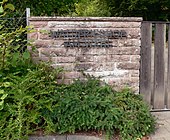Am Wehl cemetery
The "Am Wehl" cemetery is a forest cemetery in Hameln , which, with an area of 31 hectares, is the largest cemetery in the city.
history
The name of the cemetery is derived from the village of Wehle , which was located in this area from the 14th century and later fell desolate . The area around the deserted village is called Wehl . During the First World War there was a large prisoner of war camp in the area . At this time a cemetery was set up at the camp, which has long been known as the Russian cemetery . More than 700 Russian, Serbian and Belgian soldiers who died in the camp are buried on it.
In 1934, during the time of National Socialism , the construction of the cemetery began, which at that time was called the “first major labor battle” of the city of Hamelin. In 1938 the city cemetery was inaugurated, which included a chapel with a parish hall, a morgue and an administrator's house with an economic section.
description
Well-known families and personalities from Hamelin's history are buried in the cemetery. There is also a grave field for Islamic burials , a grave field for star children and a grave field for Jewish burials .
The cemetery area shows an alternation between open landscape and forest-like structures, so that there is a diversity of plants and the area offers a suitable habitat for many animals. At the cemetery several are species of bats detected as Noctule , pipistrelle , whiskered bat , Serotine , Bechstein's bat and brown long-eared . Bat boxes were installed by the cemetery administration .
Graves from war and post-war times
The cemetery is a war cemetery for more than 1,800 victims of both world wars. Among them are around 700 Russian, Serbian and Belgian soldiers from the time of the First World War on the cemetery for prisoners of war of the First World War , 300 forced laborers from the time of the Second World War , mostly from Poland and Russia, on the cemetery for foreign war victims of the Second World War ,, 195 civilian victims of the air raids on Hameln on the cemetery for German bomb victims , 200 German soldiers who died in the defense of Hameln and 390 male inmates of the Hameln prison on the cemetery for the dead of the Hameln prison in the Second World War
In Hamelin prison 201 people were executed from 13 December 1945 to 1949 by the British occupying power; 156 of them as war criminals . Of these, 82 were convicted in the Hamburg Curiohaus trials . These included those convicted of the Bergen-Belsen trial , the concentration camp guards Irma Grese , Elisabeth Volkenrath and Johanna Bormann , the camp commandant Josef Kramer , the concentration camp doctor Fritz Klein , Fritz Knöchlein and Bernhard Siebken . Other people executed were concentration camp doctors, concentration camp kapos , SS guards and commanders of SS units (2nd SS Totenkop Regiment, SS Totenkopf Division ), such as Walter Sonntag . The last execution took place on December 6, 1949 on a displaced person for the use of firearms resulting in death. The corpses were initially buried anonymously on the prison grounds and from mid-1947 in cemetery C III. All corpses from the prison grounds were reburied.
For right-wing extremists, the cemetery became a place of pilgrimage, where, for example, the Freedom German Workers' Party held a memorial hour in November 1985 and in 2015 members of the neo-Nazi women's group Düütsche Deerns laid branches, candles and stones with the names of those who were executed. The resolution of the cemetery was founded in 1974 by NPD -based citizens' initiative prevented. The leveling took place in 1986 as a result of physical disputes in the cemetery. The neighboring grave field C I with Nazi victims who died in prison before the end of the war was leveled in 1976.
Tombs (selection)
- Charles Machon (1893–1944), resistance fighter
- Elsa Buchwitz (1929–1997), local politician
Web links
- Description of the cemetery (pdf)
- Site plan of the cemetery (pdf)
Individual evidence
- ↑ Information flyer on circular hiking trails in the Hamelin city forest (pdf)
- ↑ Bernhard Gelderblom : Why are history and memorial panels for the graves of war victims in the Wehl cemetery? in Hameln's story - apart from the pied piper
- ↑ Bernhard Gelderblom: Grave field for the prisoners of war of the First World War in Hameln's history - apart from the Pied Piper
- ↑ Bernhard Gelderblom: Grave field for foreign victims of the Second World War near Hameln's history - apart from the Pied Piper
- ↑ Bernhard Gelderblom: Grave field for German bomb victims near Hamelin's story - apart from the Pied Piper
- ↑ Bernhard Gelderblom: The graves of German soldiers in Hameln's history - apart from the pied piper
- ↑ Bernhard Gelderblom: Grave field for the dead of the Hameln prison in the Second World War in Hameln's history - apart from the pied piper
- ↑ Bernhard Gelderblom: The executed in alphabetical order in Hameln's story - apart from the Pied Piper
- ^ The Hamburg Curiohaus Trials - Nazi war crimes before British military courts , p. 60, publisher: Neuengamme Concentration Camp Memorial, January 2017
- ↑ Bernhard Gelderblom: Burials at the Wehl cemetery near Hameln's story - apart from the pied piper
Coordinates: 52 ° 7 ′ 44.1 ″ N , 9 ° 20 ′ 31.7 ″ E



